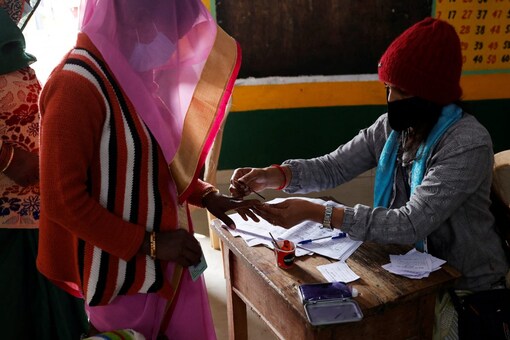UP Elections: Poll Percentage During Five Phase Same as in 2017 Assembly Elections

The Uttar Pradesh election result 2022 will be declared on March 10. (Representative image/Reuters)
Results will be declared on March 10 along with that of Punjab, Uttrakhand, Goa and Manipur.
- PTI Lucknow
- Last Updated:March 01, 2022, 15:00 IST
- FOLLOW US ON:
Voters' turnout in almost two-thirds of the assembly seats during five rounds of polling in Uttar Pradesh is more or less the same as in the 2017 polls, leaving political parties and experts guessing whether it's pro-incumbency or anti-incumbency votes. A look at the voters' turnout in the 2019 general elections in the state also doesn't reflect much of a difference. While some attribute it to coronavirus, others say voters have tested all the parties in the polls and hence are not enthused by new poll promises made by the competing parties.
Out of the seven-phase elections, the politically important state has completed five rounds and the rest two are lined up on March 3 and March 7. Results will be declared on March 10 along with that of Punjab, Uttrakhand, Goa and Manipur. The opening phase of the elections on February 10 saw a voter turnout of 62.43 per cent in the 58 assembly constituencies in western Uttar Pradesh. It was 63.47 per cent in 2017 and 61.84 per cent in the last general elections. But, Kairana which had earlier hit the headlines because of reported migration due to bad law and order saw a leap from 69.56 to 75.12 per cent voting this time.
As per data available with the election office, the second phase of polling on 55 assembly segments on February 14 registered 64.42 per cent vis-a-vis 65.53 % five years back and 63.13 % in the last Parliamentary elections. The hot seat Rampur of jailed SP leader Azam Khan saw almost a ditto voters' turnout at 63.92 per cent vis-a-vis 63.97 in 2017. The third phase which saw voting in the Karhal constituency from where Samajwadi Party president Akhilesh Yadav is contesting witnessed a 62.28 voting percentage as compared to 62.21 per cent five years back and 59.73 in the last general elections.
Reports suggest it is the second-highest voting percentage in Mulayam Singh Yadav's bastion, after 71.4 per cent in 1974. The fourth round on February 23 which saw voting in the state capital Lucknow among others on 59 seats, saw nearly 61.52 per cent voting as per voters turnout App of the Election Commission as compared to 62.55 per cent in 2017 and 60.3 per cent in 2019. Fifth-round on 61 seats including that in Ayodhya, Prayagraj, Amethi and Raebareli on February 27 witnessed 57.32 per cent voting while it was 58.24 in 2017 and 55.31 in 2019 Lok Sabha polls.
For the sixth phase on March 3 which will see voting in the high-profile seat of Gorakhpur Urban from where Chief Minister Yogi Adityanath is in the fray, the challenge is to cross the voting percentage of 56.52 in 2017. So is in the last round on March 7 which includes Varanasi, Prime Minister Narendra Modi's Lok Sabha constituency where the 2017 mark was 59.56 per cent. It was 57.48 in the last parliamentary polls.
On voters' turnout, Yogi Adityanath says it's more and less the same as last time and it means things are going in the right direction. Former Chief Election Commissioner SY Quraishi, when contacted, told PTI, "I wonder why the voter turnout has not increased this time. It could be because the voters' education efforts were less this time?" Sanjay Kumar (Professor and Co-Director of Lokniti, a Research Programme at the Centre for the Study of Developing Societies) told PTI, "If you compare with the previous elections, the turnout is not very low. It varies by 1-2 per cent.
"Normally, whenever people decide to change the government, there is an atmosphere about it, which in turn increases the turnout. This was visible in the 2014 Lok Sabha elections, as the polling percentage increased as compared to the 2009 elections," he said. "There is 'udaaseentaa' (indifference) in the minds of the voter (towards voting). Now, whether it is indifference towards anti-incumbency or pro-incumbency, it will be known only after the results are declared," the psephologist said.
State BJP spokesperson Manish Shukla said, "Irrespective of the voters' turnout, the BJP voters are coming out of their home and voting for the party. However, the same cannot be said about other political parties, as their voters seem to be inactive. This can be possibly due to the rift within the SP-led alliance." Samajwadi Party spokesperson Rajpal Kashyap said that discrepancies in the voter list and people moving out of the state for work after easing in the covid situation have reduced the polling percentage. "However, the SP is gaining ground in every phase." His Congress counterpart Ashok Singh said," It is a festival of democracy, and the party is contesting with full energy. We will throw surprising results. The slogan 'ladhki hoon, ladh saktee hoon' has ushered in a political revolution. Manoj Goswami (75), a resident of Lucknow central assembly constituency, said, "I did not cast my vote fearing that I will get infected with COVID-19.
Sushil Kashyap, a tea seller in Lucknow Latouche road says, "We have seen all the parties' governments. They all are almost the same." Amid inertia shown by many voters, the five phases witnessed some pleasant examples. In Prayagraj's Allahpur, 78-year-old Bhuri Pathak suffering from a hip fracture went to the polling station in an ambulance to exercise her franchise. In Lucknow, a mother who delivered a baby, turned up at a polling booth the next day.
There are over 14.66 lakh first-time voters (18-19 years old) in UP polls this time. Overall more than 52 lakh names of new voters were added for the 2022 polls. The count of total voters in UP polls is over 15.02 crore. Due to the covid pandemic, the Election Commission has extended voting time by an hour.
Read all the Latest News, Breaking News and Assembly Elections Live Updates here.


comment 0 Comments
more_vert